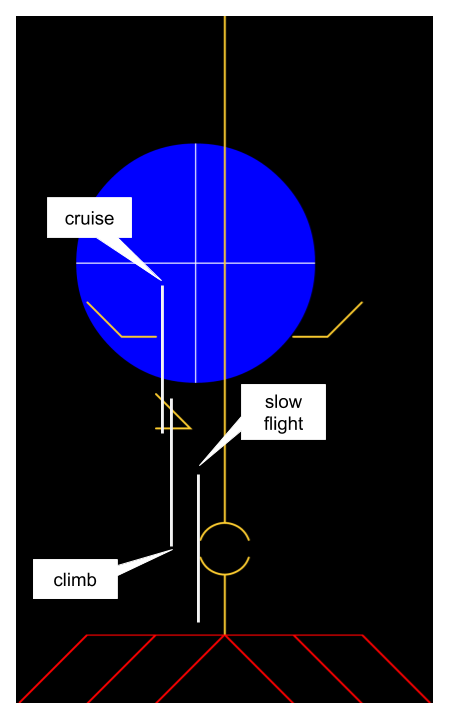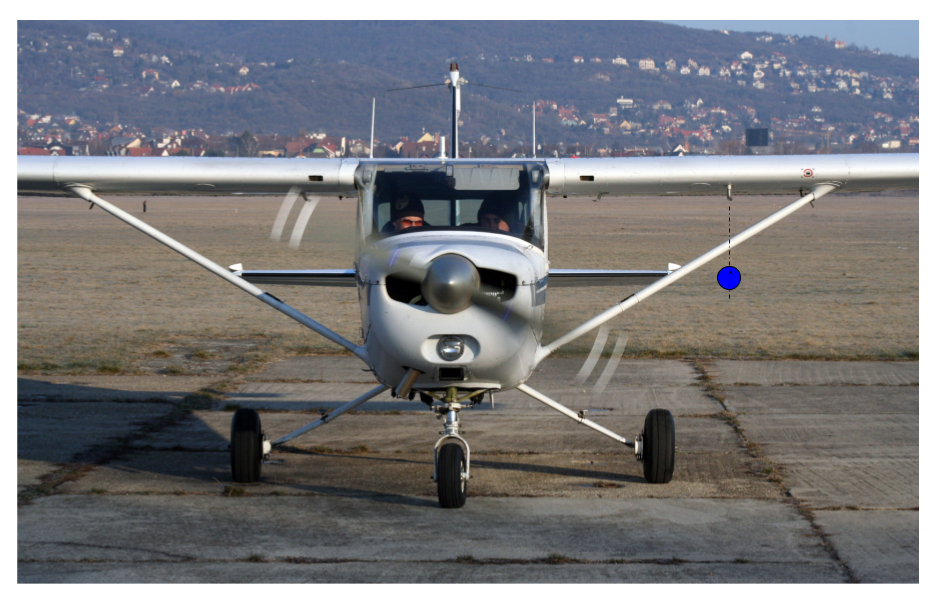Here we will analyze the yaw consistency of the flight test in this directory:
https://github.com/airball-aero/airball-embedded/tree/master/data/2018-03-09-01
Recall that we observed the positions of the Airball yaw indication, with the inclinometer centered, at the following locations:
 

The display is 480 px wide, so half of it is 240 px. We know the pixel sizes of the decorations -- they are laid out on a 20-pixel grid. And we know that full scale beta was +/- 15 degrees. So we can approximate the yaw angles that our probe computed at these conditions as:
cruise: (2.75 * 20) / 240 * 15 = 3.4 degrees
climb: (2.5 * 20) / 240 * 15 = 3.1 degrees
slow flight: (1 * 20) / 240 * 15 = 1.3 degrees
The total variation in yaw between cruise and slow flight is therefore (3.4 - 1.3) = 2.1 degrees.
Assuming that we did indeed center the ball properly in all conditions, this means we should expect, at that mounting location, to read about 2 degrees of yaw error as a result of speed variation.
Recall that this is with a "bad" mounting location that is really pretty close to the prop slipstream -- in fact, closer to the slipstream than the factory Pitot tube itself:

So for the Nth time, the question we're trying to answer here is: Is it a good idea for Airball to measure the angle of yaw directly, or is the flow near the airplane too disturbed, and should we instead settle for something like lateral acceleration normalized by our best guess of the free stream dynamic pressure?
My conclusion from this data is that we don't yet know. :) We should:
1. Try another test with the probe mounted farther outboard -- perhaps mounted a little distance vertically below the intersection of the strut and the wing.
2. In flight, play with the relative sensitivity of the Airball yaw measurement compared to the inclinometer ball, since theory says that, with reduced dynamic pressure, the inclinometer should get "mushy". Verify that the yaw deviation seen at slow flight is real.
3. Acquire some data where we correlate the probe inputs with a signal from an accelerometer. This should eliminate the pilot technique issues of trying to center the inclinometer then read the Airball location.
This should give us a bit more information to either validate our direct yaw measurement, or nudge us to do it indirectly instead.
https://github.com/airball-aero/airball-embedded/tree/master/data/2018-03-09-01
Recall that we observed the positions of the Airball yaw indication, with the inclinometer centered, at the following locations:
 
The display is 480 px wide, so half of it is 240 px. We know the pixel sizes of the decorations -- they are laid out on a 20-pixel grid. And we know that full scale beta was +/- 15 degrees. So we can approximate the yaw angles that our probe computed at these conditions as:
cruise: (2.75 * 20) / 240 * 15 = 3.4 degrees
climb: (2.5 * 20) / 240 * 15 = 3.1 degrees
slow flight: (1 * 20) / 240 * 15 = 1.3 degrees
The total variation in yaw between cruise and slow flight is therefore (3.4 - 1.3) = 2.1 degrees.
Assuming that we did indeed center the ball properly in all conditions, this means we should expect, at that mounting location, to read about 2 degrees of yaw error as a result of speed variation.
Recall that this is with a "bad" mounting location that is really pretty close to the prop slipstream -- in fact, closer to the slipstream than the factory Pitot tube itself:

So for the Nth time, the question we're trying to answer here is: Is it a good idea for Airball to measure the angle of yaw directly, or is the flow near the airplane too disturbed, and should we instead settle for something like lateral acceleration normalized by our best guess of the free stream dynamic pressure?
My conclusion from this data is that we don't yet know. :) We should:
1. Try another test with the probe mounted farther outboard -- perhaps mounted a little distance vertically below the intersection of the strut and the wing.
2. In flight, play with the relative sensitivity of the Airball yaw measurement compared to the inclinometer ball, since theory says that, with reduced dynamic pressure, the inclinometer should get "mushy". Verify that the yaw deviation seen at slow flight is real.
3. Acquire some data where we correlate the probe inputs with a signal from an accelerometer. This should eliminate the pilot technique issues of trying to center the inclinometer then read the Airball location.
This should give us a bit more information to either validate our direct yaw measurement, or nudge us to do it indirectly instead.
No comments :
Post a Comment